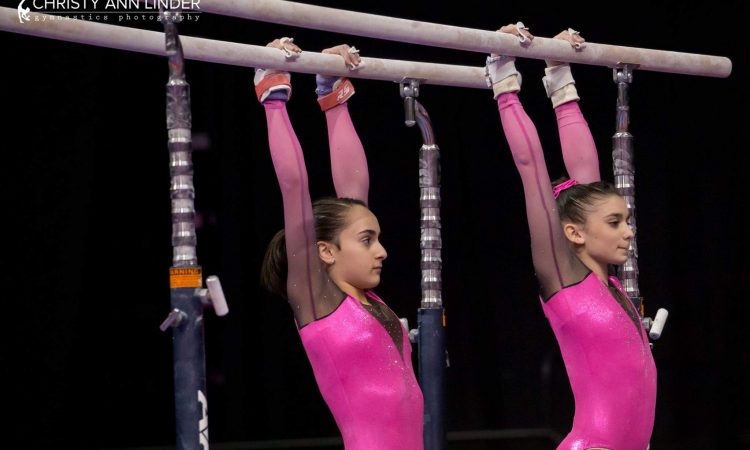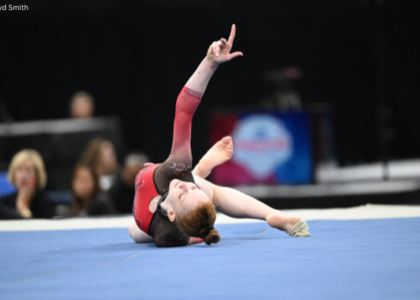When I joined College Gym News last spring, I was harboring a secret. Something I was ashamed to admit because I felt alone in this state of confusion. But I have come to learn that you have nothing to gain if you don’t ask questions, and so with that in mind I will share my confession: I had ZERO idea how anything with the J.O. system worked. I didn’t understand the code or what constituted a good score. I was very confused about how there could be multiple national champions, had no idea what the qualification process to get to regionals or nationals was or why the Nastia Liukin Cup was such a big deal (aside from the fact that it had Nastia’s name attached to it). I felt one step behind everyone else and wanted to know more about the exciting prospects and incoming freshmen, which means I needed answers.
Luckily, I am surrounded by colleagues who had answers to all of those questions (and then some), and so I invite you to join fellow editor Rebecca Scally and me as we have a conversation about all the ins and outs of J.O.
Let’s start with the basics. What’s up with the different levels and how do you advance through them?
There are 10 levels that advance athletes from kiddie recreational classes to the college level. Levels 1 and 2, and sometimes 3, are typically completed in a recreational or pre-team program and are not competed outside of the club. Starting from level 3, athletes can compete at the state level, but if a gymnast is six years old and her club coaches feel she is ready, it is common to begin competing in level 4.
After level 4, an athlete must achieve a certain score to advance to the next level. That score is either 32.000 or 34.000 depending on the level. That said, it’s common for athletes to achieve their mobility score very early in the season and remain in the same level, since it takes time to develop routines in a new level (and also since meet registration is done significantly ahead of time!).
It’s possible to skip level 6, but every other level from 4 to 9 must be competed and passed to move to the next.
Almost every NCAA gymnast was at one point a level 10, and some compete level 10 for as many as six or seven years. Some level 9s and the odd level 8 will find their way onto college teams, usually in Division III or as walk-ons. It is possible to qualify HOPES or elite without having competed level 10 prior. We see this most frequently with prodigiously talented athletes who were on a trajectory toward elite from a young age.
How is difficulty calculated? Is it different from NCAA?
It’s similar, since the NCAA code is a modified version of the level 10 rules.
Levels 1 to 5 are compulsory with routines set by USA Gymnastics. Levels 6 to 9 are optional levels with difficulty restrictions. In level 10 there are no restrictions on what skills athletes may compete and be credited with, though as in NCAA, the highest difficulty rating a skill can have is an E. As in NCAA and most 10.0 systems historically, there is a certain base score you can achieve by meeting the composition requirements. In level 10, this base value is 9.5, and as of 2020 in NCAA it is 9.4. Level 10 athletes can also start from a 10.1, not a 10.0, on vault if their routine is particularly difficult.
There are a lot of other finicky differences between level 10 and NCAA scoring, most of which you don’t need to worry about. The biggest differences are of course vault start values—a Yurchenko full starts from a 10.0 in level 10 and only a 9.95 in college—and a class of deductions referred to as “up to the competitive level” or “UTL.” UTL deductions require athletes to do just a little more and penalize routines that just about started from a 10.0 in J.O. but don’t have so many big skills and can feel trivial at the college level.
Most level 10 athletes only have to make minor changes to their routines to be prepared for college, and many already do more difficulty than is required. That said, there are occasionally issues that stem from the slightly more stringent college requirements.
How does a gymnast qualify to regionals and then qualify to nationals?
Qualifying to regionals varies a little from region to region. The basic procedure is to go to the respective state meet and score a certain qualifying score. It’s usually either a 34.000 or a 35.000 AA. If you miss that mark, you can sometimes advance on an event score or petition in based on a score achieved earlier in the season.
At J.O. regionals and nationals, there are 12 age divisions, marked Junior A to F and Senior A to F. These are determined by birth dates, and the cutoff dates for each division are determined by USAG with the intention of dividing gymnasts into twelve roughly equal groups, therefore they are slightly different each year. The cutoff dates are the same at regionals and nationals.
In theory, seven gymnasts per region per age group advance to nationals. That means that each national age division has 56 athletes and the whole competition has 672. Athletes must also score over 35.000 at regionals to advance. By finishing top seven at regionals and meeting the cutoff score, you guarantee yourself a spot at nationals. (No. 8 and No. 9 are alternates.) There are some exceptions for when gymnasts tie at No. 7, as no tie-break proceedure is used and both are allowed to compete at nationals.
That said, several regions can’t field full teams to nationals. In Region 2, for example, several age divisions had only three or four competitors at the regional level in 2019, so those athletes were guaranteed to advance if they met the qualifying score, leaving spots open on those regional age group teams. Those positions are filled by high-scoring alternates from other regions so that the national meet has a full roster.
How are there so many individual national champions? Shouldn’t there just be one?
National titles are allotted within the twelve age divisions, so there are twelve national champions each year and forty-eight event winners (or more in the case of ties).
The award structure might feel a little silly if you’re not used to it, but it’s just part of the convention of the J.O. system. A 12-year-old, first-year level 10 shouldn’t be gunning for the same title as a college-bound high school senior, right? You’ll acclimate quickly, I promise! Plus, there are meaningful differences in the types of routines you see between Junior As and Bs who are often elite hopefuls versus Senior Es who are going to be college freshmen ANY SECOND NOW.
Does qualification to the Nastia Liukin Cup have anything to do with qualifying to regionals or nationals, or is it a totally separate entity? Is one better than the other?
Nastia Cup is its own thing that has nothing to do with the rest. And while it’s decently representative, it’s imperfect in that its qualification procedure includes a specific subset of J.O. meets and only two athletes advance from each. That means that some of the best gymnasts in the country each year don’t make it to the Cup because their club doesn’t attend a qualifying meet or because their qualifying meet was unusually stacked.
A Nastia Cup title is very prestigious because there are only two champions per year, rather than, as previously discussed, 12 from nationals. That said, it’s still a slightly extraneous competition, and plenty of the very best gymnasts don’t compete their best at the beginning of March and might underperform. In that way, a national title is perhaps a more universally recognized credential since it’s part of the main trajectory of the season for all level 10 athletes. It either is a very serious credential for a college recruit, and most champions of either competition will have a bright future in elite gymnastics, NCAA or both.
Article by Kalley Leer and Rebecca Scally
Like what you see? Consider donating to support our efforts throughout the year! [wpedon id=”13158″]





Very helpful article. Thanks so much for putting it together. I’d always wondered about the multi-national champion issue, as well as how Nastia Cup fit into the bigger JO picture.